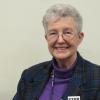There were 108 of them from five continents, representing several of the 65 affiliated congregations, plus one furry four-legged participant (half-sister, half-wolf, and all dog) named Takaari.
The group was truly intercongregational, intercultural, intergenerational and international: Four countries were represented at my table of eight on the first day of the second alumnae gathering May 25-28 in Chicago for graduates of the Collaborative Leadership Development Program.
As Global Sisters Report national correspondent Dan Stockman reported the week before the gathering, the sisters were there to hone their readiness for leadership, envision the future of religious life and prepare for collaboration, thanks to funding from the GHR Foundation.
According to St. Joseph Sr. Patty Johnson, the alumnae group evolved organically from six different leadership development programs; now, they gather to network and continue to develop the relationships that will support and nurture them into the future.
While the original participants were all in leadership-development programs in their congregation or charism groups, Mercy Sr. Sandy Prucha, director of the Leadership Collaborative graduate programs, said the program is now open to all religious who meet the criteria described on their website.
There were lots of "younger" religious. (As one said, "Where else but in U.S. religious life could a 50-plus-year-old be considered 'young'?") Actually, everyone was young at heart, judging by the degree of enthusiasm and energy. The Mass of the Ascension was full of dancing and music and featured about 12 different languages!
Facilitator Debbie Asberry with CommunityWorks Inc. based the content of the program on Margaret Wheatley's "emerging/emerged systems" and Deborah Frieze's concept of life cycles.
In the middle space between an emerged system in decline and an emerging system, there is a need for edge-walkers, wayfinders and trailblazers. They need to find each other and weave networks. As Asberry said, "It's not about critical mass. It's critical networks."
Instead of asking, "Is there a future for religious life?" she said we should ask, "What is it we can do that nurtures whatever comes out of the present?"
Without letting the past hold us hostage, we must look for ways to answer the invitation to open the door, leave home and follow our hearts. We need to deal with the grief of loss and change and not take refuge in denial and busy-ness. (One of the international sisters shared a notion from her culture: They don't say they are too busy, which tends to close others out and stands for "Being Under Satan's Yoke." Instead, they say their life is "full.")
I loved the feminine feel of the gathering, the way dancers with filmy shawls wove their way through the chattering crowd, gently hushing us, and the spontaneity with which we shared our stories in nonlinear ways. We felt instantly at home with the global sisterhood, that fundamental "connectedness" among women religious.
Of course, we acknowledged the burden of living in the "what is" and the "not yet." My favorite image from the time I spent with them was the description by one of the sisters of a film she had seen. In a close-up shot of a planet's surface, cracks are appearing in the ground and people are furiously rushing around trying to patch them shut. Then cracks appear in the ground in another place, and the same hasty repairs are made. More cracks, more frantic repairs. Then the camera pans out to get a distance shot and you can see what it is — a hatching egg!
In my short two days with the group, I was delighted to sense a new charism hatching: the charism of religious life. It is a "trans-charism" and may be the greatest gift we women religious have to give to our times.
[Ursuline Sr. Michele Morek is Global Sisters Report's liaison to sisters in North America. Her email address is mmorek@ncronline.org.]


